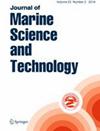Agarase Production by Marine Pseudoalteromonas sp. MHS: Optimization, and Purification
IF 2
4区 工程技术
Q2 ENGINEERING, CIVIL
引用次数: 1
Abstract
Agar is an essential polysaccharide that has been utilized in numerous fields. Many kinds of literature have been published regarding agarolytic microorganisms’ isolation and agarases biochemical studies. In this search, a local marine agarolytic bacterium associated with marine alga Ulva lactuca surface was isolated and identified as Pseudoalteromonas sp. MHS. The agarase production was parallel to the growth of Pseudoalteromonas sp. MHS as cells displayed a lag phase (2 h), subsequently an exponential growth that prolonged till 10 h where maximum growth (OD550nm = 3.9) was achieved. The enzyme activity increased rapidly as cells increased exponentially where the maximum activity of 0.22 U/mL was achieved after 8h and remained constant till 12 h during the stationary phase of growth. Agarase production was optimized using Plackett-Burman statistical design by measuring enzyme activity as a response and the design was validated using a verification experiment; the activity of the enzyme increased from 0.22 U/mL to 0.29 U/mL. Pseudoalteromonas sp. MHS agarase was partially purified and its molecular weight (MW) was determined by SDSPAGE (15-25 kDa). Agarase showed approximately 94% of its activity at 40 °C. The enzyme stability decreased as the temperature increased; the enzyme could retain about 98, 90, 80, 75, and 60% of its activity at 20, 30, 40, 50, and 60 °C, respectively. Biomass of the red alga Pterocladia capillacea proved to be a suitable substrate for agarase production using Pseudoalteromonas sp. MHS; the enzyme activity recorded after 24 h of incubation was 0.35 U/mL compared to 0.29 U/mL from the optimized medium.海洋假互生单胞菌产琼脂酶MHS:优化与纯化
琼脂是一种重要的多糖,已在许多领域得到应用。关于溶脂微生物的分离和琼脂酶的生化研究已经发表了许多文献。在本研究中,分离到一种与海藻Ulva lactuca表面相关的本地海洋溶脂菌,并鉴定为Pseudoalteromonas sp. MHS。琼脂酶的产生与假互变单胞菌MHS的生长平行,因为细胞表现出滞后期(2小时),随后呈指数增长,持续到10小时,达到最大生长(OD550nm = 3.9)。随着细胞呈指数增长,酶活性迅速增加,8h后酶活性达到最大值0.22 U/mL,在生长稳定期一直保持到12 h。以酶活性为响应,采用Plackett-Burman统计设计优化琼脂酶产量,并通过验证实验对设计进行验证;酶活性由0.22 U/mL增加到0.29 U/mL。伪alteromonas sp. MHS琼脂酶部分纯化,用SDSPAGE (15-25 kDa)测定分子量(MW)。琼脂酶在40℃时的活性约为94%。酶的稳定性随着温度的升高而降低;在20、30、40、50和60℃下,酶能分别保持约98%、90%、80%、75%和60%的活性。红藻毛鳞翼藻的生物量被证明是利用假交替单胞菌sp. MHS生产琼脂酶的合适底物;培养24 h后酶活性为0.35 U/mL,优化培养基的酶活性为0.29 U/mL。
本文章由计算机程序翻译,如有差异,请以英文原文为准。
求助全文
约1分钟内获得全文
求助全文
来源期刊

Journal of Marine Science and Technology
工程技术-工程:海洋
CiteScore
5.60
自引率
3.80%
发文量
47
审稿时长
7.5 months
期刊介绍:
The Journal of Marine Science and Technology (JMST), presently indexed in EI and SCI Expanded, publishes original, high-quality, peer-reviewed research papers on marine studies including engineering, pure and applied science, and technology. The full text of the published papers is also made accessible at the JMST website to allow a rapid circulation.
 求助内容:
求助内容: 应助结果提醒方式:
应助结果提醒方式:


